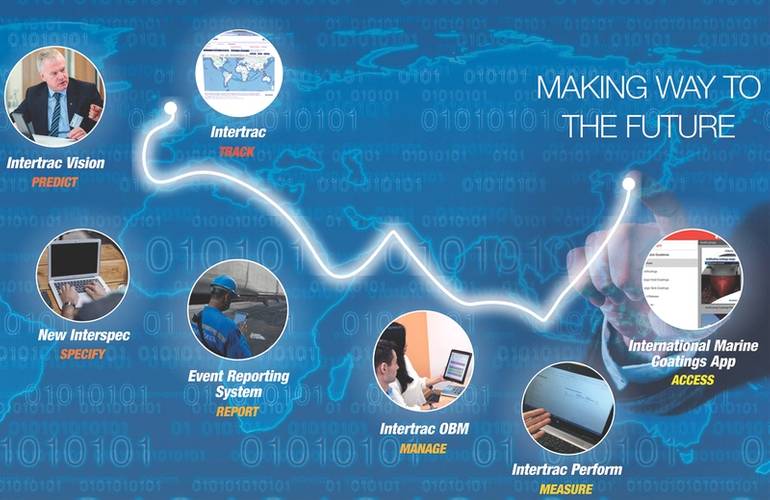At Nor-Shipping this year, Akzonobel announced the official launch of its ‘Digital Voyage’ strategy. This program builds on the foundations laid two years ago when the firm launched Intertrac Vision, the industry’s first Big Data tool for predicting coating performance. The Digital Voyage outlines the goal of putting a wealth of knowledge in the hands of ship owners and operators, and helping them make smarter, more economical and environmentally friendly decisions.
As we embark on this journey, it’s clear that, while the industry recognises the value that digital technology has to offer, the idea of a digital transformation can be daunting – particularly in an industry with challenging marketing conditions, where each operational decision can have potentially serious ramifications. So, what does the Digital Voyage mean in practice? And how can it help the industry in the here and now?
The Digital Revolution Defined
A useful place to start is to quantify what exactly the ‘digital revolution’ is. There are plenty of ways to do this, but one of the most telling metrics is the increase in the amount of data being transferred to and from vessels.
According to COMSYS, the number of active maritime VSAT installations quadrupled from 2008 (6,001) to 2014 (21,922), and it is predicted to exceed 40,000 by 2018. What this means is that the amount of data being transferred is going to increase rapidly. DNV GL now estimates that, in two years, the data capacity of the VSAT network has increased from 8.7 Gbps (Gigabits per second) to 16.5 Gbps – nearly doubling. If this trend continues – and there’s no reason to think it won’t – this capacity will reach 217 Gbps by 2025. The proliferation of digital tools in shipping is the result of an increased ability and need to turn this burgeoning mass of data that is being transferred and generated each time anything happens on board a ship into actionable insights.
One immediate use of this is better monitoring. The increased satellite coverage allows us to track data throughout a vessel’s voyage with no need for onboard hardware. Software providers such as NAPA and BMT are using this data to provide efficiency analysis of power consumption and route, benchmarking it against the global fleet. This can also shine a light on, and hopefully suggest solutions to, phenomena such as ‘Rush to Wait’, which currently costs the industry $18 billion in fuel costs.
In addition to generating insights, digital technology is also being used to increase transparency and speed up processes throughout the industry.
Blockchains – distributed, incredibly secure, ledgers of transactions, can allow nearly instant, secure transfer of assets – reducing the need for an intermediary to verify reams of documentation. Maersk, for example, sees this as a chance to track and time stamp changes in the custody of a shipment. The time and money saved here has the potential to be immense – in this instance, by-passing the thirty pieces of documentation that are needed to process an export consignment across multiple supply chain steps.
Digital & Marine Coatings?
Where does AkzoNobel’s Digital Voyage fit in? The aim is to bring together technologies that will both increase efficiencies and economies of scale, and enhance transparency and accountability, allowing users to make smarter and more ecologically friendly decisions.
One recent development that encapsulates this is Intertrac OBM (On Board Maintenance). This online tool records, visualizes and analyses OBM coating purchasing patterns by vessel and fleet, using AIS data (taking advantage of the increasing satellite coverage) to record when and where transactions occur. It then recommends how operators can streamline purchasing by, for example, avoiding small quantity orders, identifying alternative ports with greater savings potential, or product choices that can provide cost savings. Overall, the efficiencies generated could save OBM coatings costs by up to 20 percent. Since launch, many major shipping companies have shown strong interest in the application, indicating that the insights it offers, driven by big data and tangible actions to optimise efficiencies speak strongly to the operators, especially in a challenging market.
The priority for Intertrac OBM is to give users actionable tips and hints that will help them out in the here and now. Imagine if, when you went to the shops, someone had analyzed where you usually went, what you bought, and compared it to what others were doing. Then, they could recommend that you could save a little if you went to the store next door – or that by switching from brand a to b, or getting a two-for-one offer here or there, you could save a little more. It would be maddening to try to figure this out for yourself – but together, these savings would add up.
That’s exactly what Intertrac OBM does for OBM coatings and products. If you’re using a paint that could be replaced with an almost-identical, cheaper alternative, it will nudge you towards that. If you’re frequently buying at a port where you’re not getting the best rates, it will show you where you could buy more economically, how you could eliminate small-quantity ordering and save by buying in larger batches. The data that support these decisions has existed for a while – what’s new is our ability to process it and turn it into valuable information.
Another part of the Digital Voyage emphasizes transparency and accountability. Trust is vital if owners and operators are to invest in sustainable coatings and this requires performance to be accurately predicted and verified. This is where another tool, Intertrac Perform, comes in. Currently being trialled, this software measures and monitors hull performance data and validates it against predictions made by Intertrac Vision, AkzoNobel’s big data tool for coating performance prediction. Both developments are supported by the International Marine Coatings app, which allows seamless access to a wealth of coatings knowledge.
Embarking on this digital journey is a long-term project that requires changes how we work as. These tools are not designed to be used in isolation. Rather than treating digital as a bolt-on, digital tools are used throughout the wider industry, demonstrating that using technology to enhance decision-making can be straightforward, effective and, most crucially, beneficial to their bottom line.
Feeling the pressure from depressed rates and continued oversupply, every decision that vessel owners and operators take is a major one. The value of digital disruption, such as the ‘Digital Voyage’, lies in giving stakeholders the right information and the confidence they need to make the right call.
The Author
Oscar Wezenbeek is Managing Director for AkzoNobel’s Marine Coatings business.




















